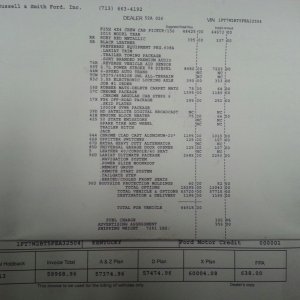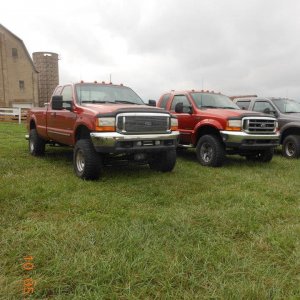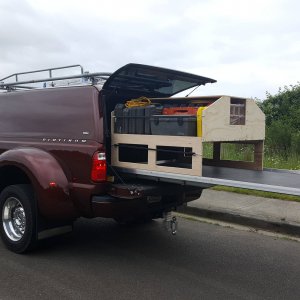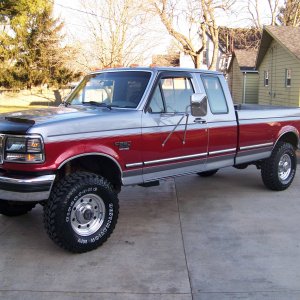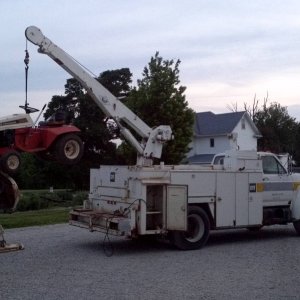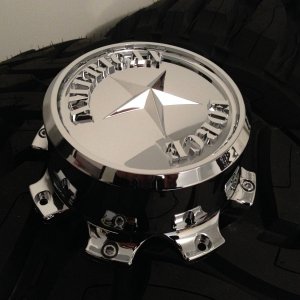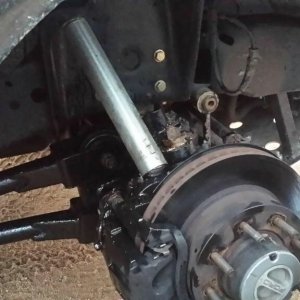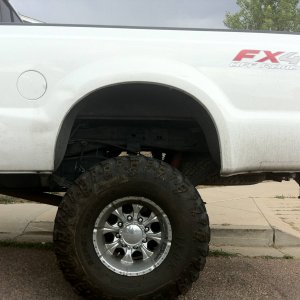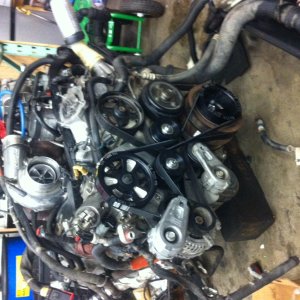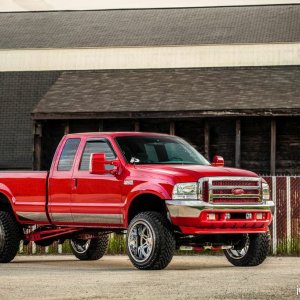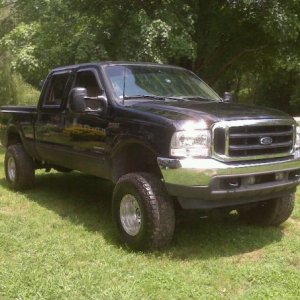Sorry I had to double check some of my numbers and have not been home much over the last few days to reply on this.
Yes because the nozzle was not the limit at those levels the limit was the oil fill and exiting the injector. When that happens you see a drop in injection pressure and you basically get actually less fuel because the oil side can not keep up with the speed the piston would have to move to keep up fuel psi.
I have to still look some more for the graph I made as it makes this very easy but here are the rough guide lines to the mechincal PW window in ratio or rpm and include the added commanded delay( commanded versus actually once the injector actual pushing fuel out the nozzle.
Mechanical Window= 42°-45° degree crank shaft rotation(CSR).
crankshaft rotation degree (CSR)to rpm per milisecond(MS) or pulse width (PW). ( in otherwords 1 ms = __°@ ___ rpm) Then we must add 0.5 to this to see what we actually COMMAND the PW to be as we must account for the delay between command and actually event.
You then have to factor 2.3-2.5hp/cc.
But you have to have those CC in the upper RPM band or the tq is just too high down low as you have to remember TQ is only one part of power twisting force but in and of itself is static. You have to have movement or work done which is the flywheel rotation in the case of these engines. Torque starts to decrease as RPMS increase because air flow and efficiency of use is limited. The more rotation in a minute the more air its using per given time. This is how HP can keep increasing while TQ decreases as more work is being down via the faster RPMs.
(The air factor is why we can get there when we use NOS as it greatly increases content and density of O2.)
So knowing this and knowing from lots of observation of diesel motors we know we can only make about 2.3 to 2.5RWHP per CC (1000 shot) of fuel ( fuel only).
Lets use the current ultimate goal for a HEUI 7.3 which is to make 1000hp fuel only to the rear wheels. To be optimistic lets use the upper limit of 2.5hp/cc
1000hp/2.5hp = 400 cc
So we need 400cc of fuel to get to 1000 hp and to do that we need a certain amount of RPM to use both the air and fuel to be burnt efficiently enough to keep this ratio of fuel to HP. We also have to limit tq to something "A" that will keep the engine together and "B" that can be something we can at least use a large % of. To get more HP up top we need to correspondingly increase the TQ levels at higher RPMS.
I am going off memory here as I have nto found the chart yet but IIRC:
The effective fueling window or PW window is about 45° of crankshaft rotation for each cylinder. I think it was roughly 6° of Crankshaft rotation per 1000 rpms =1 ms of PW time. You can then subtract this fro the 45° to see how many MS of PW time you have for a given RPM. This is the actual mechincal window. There is still injector delay thus we need to account for this to get commanded PW as we have in the tunes. That delay should be constant and I beleive is 0.5ms. That needs to then be added to the mech PW window to get the commanded PW.
We will use best case scenario of 45° available crankshaft degrees.
Total Available Pulse Width (TAPW) in Milliseconds for each rpm bracket
1000rpm = 06.0° CSR / MS = 7.50 ms TAPW = Commanded: 8.00 ms
1500rpm = 09.0° CSR / MS = 5.00 ms TAPW = Commanded: 5.50 ms
2000rpm = 12.0° CSR / MS = 3.75 ms TAPW = Commanded: 4.25 ms
2500rpm = 15.0° CSR / MS = 3.00 ms TAPW = Commanded: 3.50 ms
3000rpm = 18.0° CSR / MS = 2.50 ms TAPW = Commanded: 3.00 ms
3500rpm = 21.0° CSR / MS = 2.14 ms TAPW = Commanded: 2.64 ms
4000rpm = 24.0° CSR / MS = 1.87 ms TAPW = Commanded: 2.37 ms
4500rpm = 27.0° CSR / MS = 1.66 ms TAPW = Commanded: 2.16 ms
5000rpm = 30.0° CSR / MS = 1.5 ms TAPW = Commanded: 2.00 ms
So we need to be making peak HP somewhere in the 4.5K-5K range. Thus we need to be able to dump at least 400cc of fuel in a commanded 2.0-2.20
But now consider the oil side of things. But do not consider it in terms of total flow per minute but consider it in terms of flow rate per time or crankshaft degrees of movement during a injector PW time period.
What does it take to move 400cc of fuel. We always talk in the flow bench flow rates but this does not really give the accurate picture. They are done per 1000 shots so the differences can be read easily.
400cc / 1000 shots = 0.4 cc per injector firing.
oil to fuel ratio of a hybrid = 5:1
0.4cc of fuel = 2cc of oil displacment
Standard 17° HPOP displaces 7.2cc per revolutions and rotates @ 85% crankshaft rotation.
That is a perfect world. Lets just drop off the 0.2 cc to take care of the real world inefficiencies that are in the system and that is conservative IMO.
Now everyone is going to be running at least a dual hpop system at that level So for arguments sake we double the displacement amount so 14cc per full HPOP gear rotation. But its 85% of the crankshaft so we need to reduce this to displacement per crankshaft rotation or for every RPM level we will have to recalculate for the 85%.
14cc x 85% = 11.9 cc per CSR of 360°
We all I think understand that the higher the RPM of the engine the more oil the HPOPs are displacing in given period of time. Thus if there is not enough oil displacement a given RPM no rpm below that will be able to displace more oil. So we are all on the same page now.
If we look at the chart above it gives us a chart of crankshaft degrees of rotation for a given time period in this case per millisecond.
We have to keep in mind with only have a limited amount of crankshaft degrees of rotation to inject our fuel. This means we are always limited by the fixed amount of CSR being 45° but time or PW window varies with RPM ( getting shorter)
The crankshaft degree rotation window being fixed is critical as it gives us a maximum rate for oil flow per RPM. You get forget about all the PW times as this is the best or most the HPOP system can support or its max displacement flow rate.
So we know that a dual 17° HPOP setup can possibly displacement 11.9cc of oil per 360° crankshaft rotation.
We know the maximum crankshaft rotation for a given cylinder that will ensure the fuel hits the piston bowl is 45°.
45° is 1/8 of the full 360° of rotation or 12.5%
11.9cc per CSR x 12.5% = 1.4875cc
1.4875cc This is the most oil a dual HPOP can displace per injection event regardless of the RPM. So any PW window is going to have to be a fraction of this or guess what P1211 !!
The rotational degrees all works out as we have a 8 Cyl 4 stroke engine. For every 360° of rotation 4 cylinders fire or 90° of rotation per cyl of that 1/2 of that piston movement in the window that given injector angle and spray pattern will have the majority hitting the piston bowl where it belongs and can be used.
Now you begin to see why you need big oil even with stock B codes and why as the nozzle size goes up and increase fuel flow per time you need more oil volume.
Now what do we have
Fixed ratio of oil to fuel at the injector: 5:1 (Forget any of the oil restrictions)
Maximum displacement of HPOP oil per CSR: 11.9:1
Maximum crankshaft window for injection: 45°
Maximum HPOP oil displacement per 45° CSR or per injection window: 1.4875cc
This means we can see, mathematically, what is the most fuel a dual HPOP using a "hybrid 5:1" injector can supply for a given PW at full 3K psi
1.4875cc / 5 = 0.2975cc per injection event
0.2975cc x 1000 shot = 297.5cc of fuel
We can see the maximum amount of fuel a dual 17° HPOP using a hybrid injector can support its injection pulse. Or the amount of oil displacement available or any injector by computing the hydraulic ratio This is also factoring in the assumption that there are no oil flow restrictions in the injector or they have all been fixed which of course is not the case and is the reason we do not see current hpops fizzing out..
To see this thru consider what we have seen in terms of RWHP There is a HP:fuel cc ratio range you see thrown around quite a bit in the P-pump and HEUI world its 2.3-2.5 HP per cc of fuel.
Is it not interesting that this seem to fit very well with the max HP we have seen in HEUI fuel only?
300cc x 2.3-2.5cc = 690-750HP Interesting coincidence isn't it!?!
TO BE VERY CLEAR: I am not saying more fuel can not be injected as it can just not inside this window where ideally needs to be (to keep it in piston bowl) if you want to keep that engine together and or make HP not just more smoke or for other reasons such as cooling egts as done with puller setups.
Obviously a Gen III with its gear pump can do even more but when you look at what it takes to get 400cc of fuel which is 2cc of oil run the numbers are you will see that standard dual hpops falls 25% short on needed displacement and that is maxed out.and then add in the real world decreases in efficiency that happen at the higher flow rates and the dynamics of the oil moving in and out of the injectors that maybe push it as well.
Next consider how much oil that is also needed for the engine lubrication and how much extra is needed to be pulled thru the HPOP res to support this system at these flow rates. What happens a higher RPM but lower demand i.e holding a gear longer but light throttle. The injectors are using very little of the oil so its all being bypassed but still the HPOP pumps are fixed to rpm so they are pushing all this oil thru those little IPR orifices and what about the LPOP that is to support this amount of oil flow to the HPOP res.
Consider that currently a dual HPOP is pulling 11.9cc per CSR of oil and we need a min of 25% more.
3000 rpm instead of 9.43 gallons per minute going thru the HPOP res it will now need to be 11.79 gallons per minute and to be frank I think we actually need more or that other issues in the system may start showing itself. Can even the DS HV LPOP even keep up with this demand and still hold need flow thru the engine or do we need a external gear or belt oil pump to support a HPOP system of this size?
It seems that if all the oil restriction issues were gone from out hybrid injectors and they kept the 5:1 ratio even the DS HV LPOP could not keep up with the demand needed by a hpop system that could supply the needed oil to run those injectors without oil side restrictions once we past this current limit threshold.
This also gives clear evidence why a using B code with standard Barrel and plunger ratios even if you could flow all the oil in and out without restriction could not be supported by even most big oil.
Take a 6:1 ratio for 0.4cc of fuel instead of 2cc we now need 2.4 cc or another 17% more so instead of 25% deficit its 42%
Point being we have oil supply issues and or oil need issues. This is why any new injector parts IMO need to have a lower B

ratio and that other adjustments inside the injector can be made to still get higher resolution and thus injection quality.
Look what happens if we change that injector ratio to 4:1 or then 3:1
4:1 ratio
4:1 ratio = 1.6cc oil : 0.4cc fuel
3:1 ratio = 1.2cc oil : 0.4cc fuel
We are now in the range of oil displacement that dual HPOP and certainly GenIII setups can support for getting the fuel in a window for good clean power.
I wanted to bring this up as it has been brought up before once or twice over the last 15 yrs but it seems to be pushed aside, discounted, heads in the sand sort of response, and nothing done about it; just going with the status quo where we have not really advanced much of anywhere in terms of making more peak power. Yes we have come some way in tuning etc and learning how to keep the bottoms together better but we could have oh oh so much more if some changes were made to the hard parts such as the injectors rather than using OEM and just mix and matching maybe a bit of machine work here and there but never addressing the real fundamental problems holding this system back. With those changes 1000RWHP+ is without a doubt doable and with heavy NOS fogging could with some luck be knocking at 2K door.

